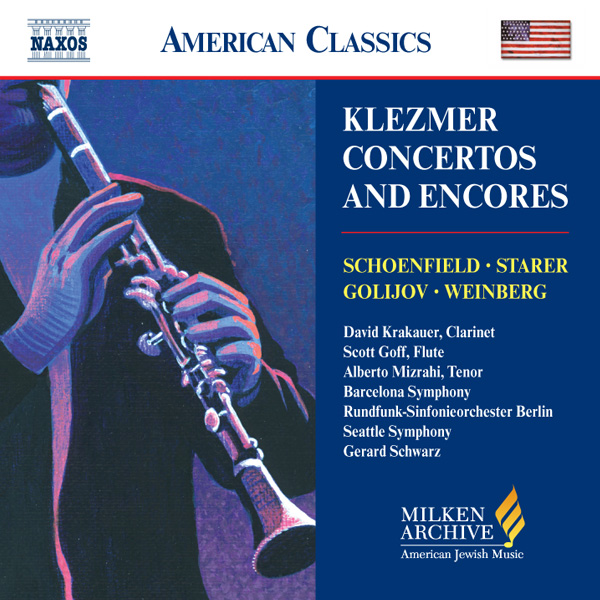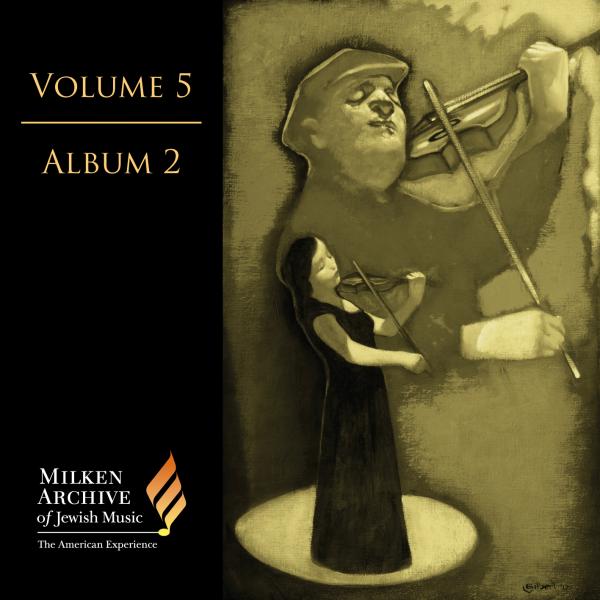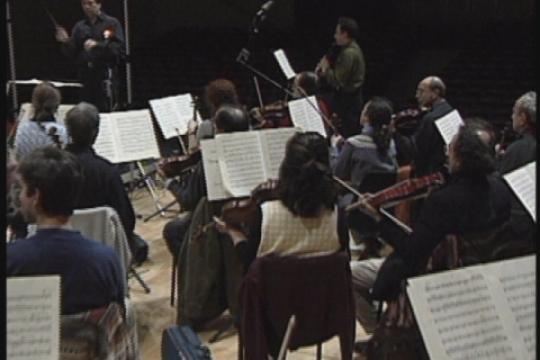Tracks
Liner Notes
Paul Schoenfield’s Klezmer Rondos, written for flutist Carol Wincenc in 1989 on commission from the National Endowment Consortium Commission Grant, was originally conceived for a small accompanying ensemble in order to portray some of the typical eastern European klezmer band idioms in the context of a cultivated concert work in the Western classical mold. The piece was revised and expanded in 1995 for its New York Philharmonic premiere and became a concerto for flute, tenor, and symphony orchestra. The new orchestration calls for a contemporary incarnation of an eastern European klezmer band, with some historically emblematic instruments along with other, atypical ones: E-flat (doubling on B-flat) clarinet; alto (doubling on soprano) and tenor saxophones; trumpet; cornet; trombone; tuba; an elaborate battery of percussion; piano; and strings.
The explosion of interest in America during the past three decades in the musical styles of 19th-century eastern European klezmer bands has accorded special focus to the solo virtuoso clarinet as the carrier of the stereotypical sonorities, flourishes, timbres, and special effects associated with those traditional ensembles. Other instruments, however, such as the violin and the trumpet, were at various times and in various locales at least equal contenders for that role, especially in the earlier stages of the klezmer band format. That the flute often played a major solo role in Europe is less commonly realized—especially in America during the first half of the 20th century, when such ensembles were almost never called “klezmer groups,” but simply “wedding bands.”
Yet some of the most celebrated eastern European klezmorim were flutists, such as the Polish-Jewish klezmer Michal Jozaf Guznikow (1806–37), so Schoenfield’s choice of flute for this concerto is as historically appropriate as clarinet or violin. The flute doubles on piccolo as well here, giving added emphasis to the ecstatic, piercing character of certain idiomatic klezmer band sounds.
Schoenfield has noted that he was especially conscious of the historical role not only of the klezmer, but also of the professional badkhn—the jester, vocal merrymaker, quasi–folk singer, and overall entertainer at Jewish weddings in eastern Europe, especially outside larger cosmopolitan cities, and in western Europe before the modern era. Those badkhonim complemented the function of the instrumental musicians—a tradition dating to premedieval eras, as does the role of secular wedding musicians for pre and post-ceremonial festivities. For a long time after the destruction of the Second Temple, all instrumental music and even secular vocal music was prohibited, as a sign of collective mourning. But so important in Judaism is the mandate for rejoicing at weddings, and assisting the bride and bridegroom to rejoice, that the related festivities were (along with Purim) the first occasions to be excepted by rabbinical authority. Professional badkhonim are even mentioned in the Talmud for other roles. So, although “klezmer” denotes a strictly instrumental musician, Schoenfield’s incorporation of a singing role as a paired presentation with klezmer idioms seems legitimately derived from the badkhn tradition.
Klezmer Rondos quotes directly the opening section of a song of the Lubavitcher Hassidim, Kol dodi (Voice of My Beloved), from Song of Songs, attributed to the first Lubavitcher—or ḥabad—rebbe, Rabbi Shneier Zalman of Liady. A variation is often attributed to rebbes of different dynasties who were Rabbi Zalman’s contemporaries. There is also the quotation of a well-known Lubavitcher niggun rikkud (dance tune), as well as other typical idiomatic Hassidic phrases and inflections throughout.
In discussing this work, Schoenfield identified the musical elements as those generally associated (in contemporary perception) with klezmer music, i.e., eastern European modes, Gypsy scales and modes, quasi and even pseudo-Hassidic songs and dances (often borrowed originally from local non-Jewish folk tunes), marches, Romanian dances, and Yiddish folksong motifs. An original Yiddish song in folk style, to the poem Mirele by Michl Virt, concludes the first of the two movements.
In the program annotations to the New York Philharmonic premiere, critic Bernard Jacobson referred to Klezmer Rondos as representing a sort of pluralism of voices and idioms from the various cultures now heard in America that serve as inspirational sources for American composers. He also astutely observed that some of the related folk inflections (in this case, the klezmer sounds) are, or can be, as much a part of Slavic and Hungarian traditions as of Jewish heritage alone. To those “foreign” origins one can add Romanian and Gypsy precursors. But these elements are used by Schoenfield in an entirely original way, organically integrated and infused within the piece and rising above a mere pedestrian quotation of tunes. That procedure seems to be characteristic of Schoenfield’s work in general. One publisher has commented, “He frequently mixes ideas that grew up in entirely different worlds, making them talk to each other...and delighting in the surprises their interaction evokes.” That assessment is particularly applicable to this work.
Klezmer Rondos was one of the first serious and successful attempts to employ the eastern European klezmer melos within a classical art music as well as symphonic framework. In this adventure Schoenfield has recalled Bartok’s penchant for using authentic Hungarian folk material in symphonic and chamber works, and Gershwin’s integration of indigenous American jazz features into classical forms such as the piano concerto and opera.
Lyrics
MIRELE
Written by Michl Virt
Translation by Eliyahu Mishulovin
Mirele.
The daughter of Dvoyrele the storekeeper is called: pretty Mirele, Mirele!
And Dvoyrele says that her only consolation is Mirele.
The sun shines by day, the moon by night, and Mirele stands by the window and laughs.
Mirele is charmingly, deliciously beautiful.
She has milk-white hands, pearly white teeth.
The boys become all pale from longing for her, but Mirele’s heart is colder than ice, ay, Mirele, ay Mirele...
Under Mirele’s window they all swarm;
Mirele sees the most handsome young men silent and still.
The sun shines by day, the moon by night, and Mirele stands by the window and laughs.
Ay Mirele, ay Mirele...
Sighs are flying up to heaven.
They can neither eat nor sleep.
Their hearts are bursting from pain and suffering, but no one could move the frozen heart of Mirele, of Mirele...
The years flow by like water, your beauty has come to an end,
your face has already darkened, your head hunched,
your eyes are bloodshot, and your braid is already gray.
The stars glow, the moon shines by night.
She stands by the window, saddened and pensive.
The clouds float hither and thither, from Mirele’s sad eyes a tear drops,
Mirele, cry, Mirele, cry Mirele...
Credits
Composer: Paul SchoenfieldPerformers: Scott Goff, Flute; Alberto Mizrahi, Tenor; Gerard Schwarz, Conductor; Seattle Symphony, Seattle Symphony
Publisher: Migdal Publishing


